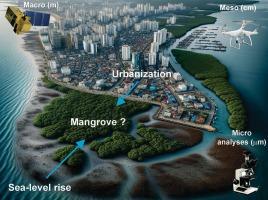Squeeze of Brazilian subtropical mangroves from a Holocene and Anthropocene perspective
IF 5.7
1区 农林科学
Q1 GEOSCIENCES, MULTIDISCIPLINARY
引用次数: 0
Abstract
Globally, mangroves are expected to expand into subtropical latitudes and higher elevations due to rising temperatures and sea-level over the coming decades. However, local geomorphology and coastal urbanization may strongly modulate these responses. Insights into mangrove responses to environmental changes can be gained from the last millennium, a key period marking the transition from natural to anthropogenic influence. Remote sensing and multi-proxy analyses from a subtropical Brazilian coast revealed the presence of mangroves on elevated flats (>1.5 m above mean sea level, msl) around ∼1700 cal yr BP. These mangroves migrated to lower flats (∼70 cm below current msl) by ∼530 cal yr BP (1420 CE), in response to a relative sea-level (RSL) fall. This trend contrasts with the RSL rise since the end of the Little Ice Age (LIA, ∼1300–1850 CE), which has since driven landward mangrove migration in the area. Additionally, recent warming in South America has facilitated the poleward expansion of Rhizophora species, contributing to an increase in mangrove canopy height (from 1 to 3.5 m) over recent decades. While global warming favors latitudinal expansion and canopy growth, the availability of suitable land is critical. Elevated terraces, which served as refuges for coastal wetlands during the mid-Holocene high sea-level stand, are now urbanized, limiting future establishment. Thus, mangrove expansion into temperate latitudes and landward migration hinge on horizontal space availability and the degree of urban development. Gentle terrain (slopes of 1.3–0.8 %) supports mangrove persistence, while steep slopes (>14 %) and urban encroachment threaten their survival. Without adequate space for migration, the region may face a net mangrove loss—termed “mangrove squeeze”—between 2100 and 2160 CE.

全新世和人类世视角下巴西亚热带红树林的挤压
在全球范围内,由于未来几十年气温和海平面上升,预计红树林将扩展到亚热带纬度和更高海拔地区。然而,当地地貌和沿海城市化可能强烈调节这些反应。从上个千年这一标志着从自然影响向人为影响过渡的关键时期,可以深入了解红树林对环境变化的反应。来自亚热带巴西海岸的遥感和多代理分析显示,大约1700 cal - yr BP左右,在高架平原(平均海平面以上1.5 m)上存在红树林。这些红树林在距今约530 cal yr BP(公元1420年)因相对海平面(RSL)下降而迁移到较低的滩地(低于当前海平面约70厘米)。这一趋势与小冰期(LIA,约1300-1850 CE)结束以来的RSL上升形成对比,后者推动了该地区红树林向陆地迁移。此外,最近南美洲的变暖促进了根藻物种向极地扩张,导致近几十年来红树林树冠高度增加(从1米增加到3.5米)。虽然全球变暖有利于纬度扩张和冠层生长,但合适土地的可用性至关重要。在全新世中期,高架梯田曾是滨海湿地的避难所,现在已经城市化,限制了未来的建设。因此,红树林向温带地区的扩张和向陆地的迁移取决于水平空间可用性和城市发展程度。平缓的地形(坡度为1.3 - 0.8%)有利于红树林的持续生长,而陡坡(坡度为14%)和城市侵蚀则威胁到红树林的生存。如果没有足够的迁徙空间,该地区可能在公元2100年至2160年之间面临红树林的净损失——称为“红树林挤压”。
本文章由计算机程序翻译,如有差异,请以英文原文为准。
求助全文
约1分钟内获得全文
求助全文
来源期刊

Catena
环境科学-地球科学综合
CiteScore
10.50
自引率
9.70%
发文量
816
审稿时长
54 days
期刊介绍:
Catena publishes papers describing original field and laboratory investigations and reviews on geoecology and landscape evolution with emphasis on interdisciplinary aspects of soil science, hydrology and geomorphology. It aims to disseminate new knowledge and foster better understanding of the physical environment, of evolutionary sequences that have resulted in past and current landscapes, and of the natural processes that are likely to determine the fate of our terrestrial environment.
Papers within any one of the above topics are welcome provided they are of sufficiently wide interest and relevance.
 求助内容:
求助内容: 应助结果提醒方式:
应助结果提醒方式:


